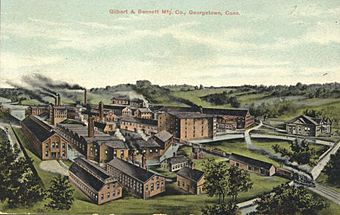Georgetown Historic District (Georgetown, Connecticut) facts for kids
Quick facts for kids |
|
|
Georgetown Historic District
|
|

Gilbert and Benett manufacturing plant, 1909
|
|
| Location | Roughly bounded by US 7, Portland Ave., CT 107, and the Norwalk River, Redding, Connecticut and Wilton, Connecticut |
|---|---|
| Area | 125 acres (51 ha) |
| Architectural style | Colonial Revival, Bungalow/Craftsman, Italianate |
| NRHP reference No. | 87000343 |
| Added to NRHP | March 9, 1987 |
The Georgetown Historic District is a special area in Georgetown, Connecticut, that has been officially recognized for its important history. It covers the main part of the village and spreads into nearby towns like Redding, Weston, Wilton, and Ridgefield.
This district includes the old Gilbert & Bennett factory, homes built for the factory workers, other private houses, and the main business area of Georgetown. It's like a time capsule showing how a rural industrial town used to be.
Contents
What Makes Georgetown Historic?
The Georgetown Historic District is a rare example of how a factory town grew in the countryside. It shows a unique part of America's industrial past. The district was officially listed on the U.S. National Register of Historic Places on January 21, 1987. This means it's a place worth protecting for future generations.
How the Gilbert & Bennett Company Started
The story of Georgetown's industry began with Benjamin Gilbert. He started a small business weaving animal hair from cows and horses. This was a "cottage industry," meaning people worked from their homes.
The company needed water power to run its machines. So, it used an old sawmill building near the Norwalk River. At first, the company made sieves from animal hair. These were tools used to separate things, like sifting flour.
From Hair to Wire: New Products
Over time, the company grew and changed. After a big fire, it decided to focus on making products from wire. They became famous for:
- Woven wire cloth, used for "meat safes" (old-fashioned food storage).
- The very first insect wire screening, which helped keep bugs out of homes.
- Chicken wire, used for fencing and other purposes.
A Community Built Around the Factory
The Gilbert & Bennett company was very involved in the community. It was guided by ideas from the 1800s that focused on helping workers and the town. This helped create a community that looked like a "utopian" village, where the factory and homes were closely linked.
The historic district covers about 125 acres. It is roughly bordered by Route 7, Portland Avenue, Route 107, and the Norwalk River. Within this area, there are 120 important buildings and one other historic site.
Architectural Styles You Can See
The buildings in the Georgetown Historic District show different styles of architecture. These include:
- Colonial Revival
- Bungalow/Craftsman
- Italianate
These styles add to the unique look and feel of the historic area.
Protecting the Historic District
Some parts of the Georgetown Historic District are also protected by local rules. For example, 14 properties in the town of Wilton are part of Wilton's Historic District #6. This district was created in 2007. If someone wants to change the outside of these buildings, they need approval from the Wilton Historic District and Historic Property Commission.
Sadly, some of the original historic buildings have been torn down. This happened as part of a project to redevelop Georgetown.
Plans for the Old Factory Site
Since the Gilbert & Bennett factory closed, many people have tried to bring new life to the area. They want to create a "mixed-use village." This means it would have both homes and businesses.
In 2005, one of these plans even won a special award from the U.S. Environmental Protection Agency. It was called the National Award for Smart Growth Achievement.
National Park Service Interest
In 2007, the U.S. Department of the Interior wanted to use part of the old Gilbert & Bennett factory site. They asked Congress for permission for the National Park Service to use the space. This space would help with managing and supporting the Weir Farm National Historic Site in Ridgefield. At that time, the National Park Service could only get expansion space in Ridgefield and Wilton.
Images for kids




